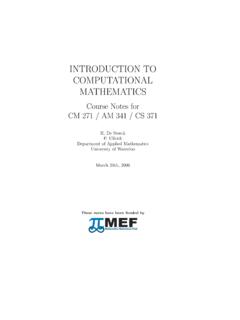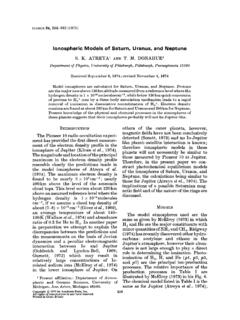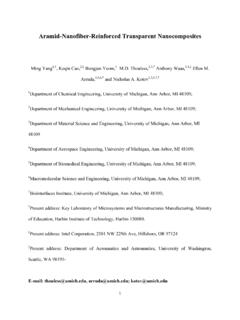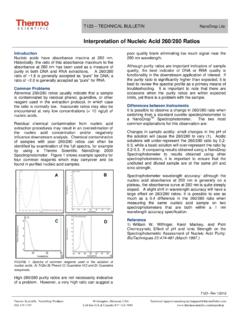Transcription of Econ 102 Homework #9 AD/AS and The Phillips Curve
1 Econ 102 Alan Deardorff Winter Term 2007 Homework #9 Solutions Econ 102 Homework #9 AD/AS and The Phillips Curve 1. As on previous Homework assignments, turn in a news article together with your summary and explanation of why it is relevant to this week s topic, AD/AS and The Phillips Curve . 2. If the government increases its purchases by $100 billion, how will this shift the aggregate demand Curve ? Under what circumstances would it shift horizontally by exactly $100 billion? What aspects of economic behavior would cause it to shift by more than $100 billion? What aspects would cause it to shift by less? This is a change in government purchases, G. Since G is one component of aggregate demand, this increase will shift the AD Curve to the right.
2 The size of the shift may be larger or smaller than the increase in purchases itself, $100 billion. There is a multiplier effect that tends to make it larger, and also a crowding-out effect that tends to make it smaller. The horizontal shift of AD would therefore be exactly $100 billion only if these two effects happened to exactly cancel each other. To explain further, the multiplier effect works because any increase in purchases, when it leads to increased production, causes incomes of producers (wages and profits) to rise as well. These producers typically spend a large fraction of this increase in income on consumption, which is also a component of aggregate demand. Thus AD shifts to the right by not just the amount of the increased G, but also by the amount of the induced increase in C.
3 And since each increase in C also causes a further increase in production, income, and therefore C, the multiplier effect includes a whole chain of increases in C as well as the increase in G. The crowding-out effect, in contrast, works through the short-run money market, the interest rate, and investment. As income rises due to the increase in G (and induced increases in C), demand for money rises to finance these transactions. Assuming (as we do) that the central bank holds the money supply constant and also (since we are looking now at the horizontal shift of AD and thus at a fixed price level) that the price level also remains unchanged, this rise in demand for money will require a rise in the interest rate to clear the money market.
4 The rise in the interest rate will in turn reduce investment, I, which is yet another component of AD. This is why the crowding-out effect acts to reduce the size of the horizontal shift of AD due to the increase in G. 3. Suppose that the US economy is initially, in the year 2003, in long-run equilibrium with zero inflation and the natural rate of unemployment, as shown at point A in the following figure. Assume that the labor force in the US totals 100 million people. 1 Econ 102 Alan Deardorff Winter Term 2007 Homework #9 Solutions Assume further that the following is the aggregate production function: Y = 100,000L, where Y is real GDP in US$, and L is the number of employed labor.
5 PY in billions of US$9,500AD1 SRAS1 LRAS100AD2102AB9,900(a) Find the natural rate of unemployment. The natural rate of unemployment is the rate of unemployment at the long run equilibrium. Since aggregate demand Curve (AD1), short-run aggregate supply (SRAS1) and the long run aggregate supply Curve (LRAS) all intersect at point A, the economy must be at long-run equilibrium at that point. Using the production function we can find the number of employed workers at the long-run equilibrium: 9,500 billion = 100,000 L L = 95 million. Since the labor force is 100 million, there must be 5 million unemployed people. Then the natural rate of unemployment is 5%. (b) Suppose now that in the year 2004 a fiscal expansion takes the economy to point B on the above graph.
6 Calculate the unemployment rate for 2004 and the inflation rate that has occurred from 2003 to 2004. At point B, the level of output is $9,900 billion. Using the production function, that output level implies 99 million employed labor. Since the labor force is 100 million people, the number of unemployed in the economy will go down to 1 million, implying an unemployment rate of 1%. The move from point A to B increases the price level from 100 to 102, a 2% 2 Econ 102 Alan Deardorff Winter Term 2007 Homework #9 Solutions increase. So, at point B the inflation rate has been 2%, and the unemployment rate is 1%. (c) What is the equation of a typical short-run Phillips Curve ?
7 What does it imply about the relation between the inflation rate and the unemployment rate in the short-run? What is the effect of an increase in expected inflation? Typically, a short-run Phillips Curve has the following form: Unemployment rate = Natural rate a (Inflation rate Expected Inflation) (or as done in lecture: Inflation rate = Expected Inflation + b(Natural rate Unemployment rate) where b=1/a>0.) That is, because the coefficient of the inflation rate in the first equation, a, is negative (or because the coefficient of the unemployment rate in the second equation, b, is negative), there is a negative relation between the inflation rate and the unemployment rate.
8 As can be seen from the above function, an increase in expected inflation will increase the unemployment rate corresponding to any given actual rate of inflation. This is an outward, or upward, shift in the short-run Phillips Curve . (d) What was the expected inflation rate in the initial long-run equilibrium at point A above? At the long-run equilibrium point A, the actual inflation rate is stated to be 0%, and the unemployment rate was found to be 5%. The Short-run Phillips Curve equation must hold for the unemployment and the inflation rate at this long-run equilibrium: At the long-run equilibrium: 5% = 5% - a(0% -Expected Inflation) Therefore Expected Inflation = 0% (e) Using the initial long-run equilibrium point A, together with point B, find the value for the parameter a of the short-run Phillips Curve .
9 At point B, since the expected inflation does not change in the short-run: 1% = 5% a ( 2% 0%) 4% = 2a a= 2 Therefore, the short-run Phillips Curve has the following function: Unemployment rate = 5% 2 (Inflation rate 0%) 3 Econ 102 Alan Deardorff Winter Term 2007 Homework #9 Solutions (f) Draw the short-run Phillips Curve that you found, labeling the coordinates of the points on it that correspond to points A and B above. Using point B, and the long-run equilibrium point we get the following short-run Phillips Curve . Inflation rate Unemployment rate 1% 2% B 5%0% A (g) Suppose now that the Fed begins to manage the money supply so as to keep the inflation rate at 2% in 2005 and subsequent years.
10 Show in the figure that you ve drawn where you would expect the economy eventually to end up. Describe in words the path that it might take to get there. By maintaining the inflation rate at 2% indefinitely, the Fed assures that eventually this rate of inflation will be expected, thus shifting the short-run Phillips Curve up to the position shown, corresponding to expected inflation of 2% and the natural unemployment rate of 5%. It is at these rate, and thus at point C, that the economy must eventually settle. Inflation rate Unemployment rate 1% 2%B 5% 0%A C The path to get there might follow something like the dashed arrow shown.














